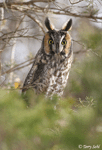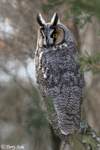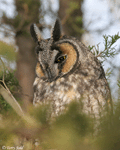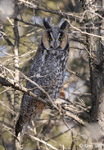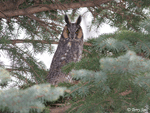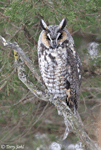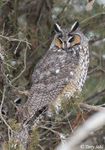| Length: 13 - 16 inches | Wingspan: 36 - 42 inches | Seasonality: All Seasons |
| ID Keys: Horizontal stripes on belly, long ear tufts, slimmer than Great Horned Owl | ||
 The Long-eared Owl is often overlooked, due to its extreme
nocturnal habits and ability to "freeze" and blend in with its habitat
. Often the best means of locating one is to find the large accumulation
of droppings and pellets underneath its roost, which it tends to use for many
days at a time. Groups of Long-eared Owls are sometimes found roosting
together in conifer groves during the winter.
The Long-eared Owl is often overlooked, due to its extreme
nocturnal habits and ability to "freeze" and blend in with its habitat
. Often the best means of locating one is to find the large accumulation
of droppings and pellets underneath its roost, which it tends to use for many
days at a time. Groups of Long-eared Owls are sometimes found roosting
together in conifer groves during the winter.
Habitat: Generally prefers mixed habitats of trees for roosting with nearby open areas for hunting, but can be found in a very wide variety of habitats.
Diet: Primarily feeds on small rodents. Will also eat small birds, lizards, frogs, snakes, and bats.
Behavior: Primarily hunts at night, usually by flying slowly close to the ground, locating prey by both sight and sound.
Nesting: April through June
Song: Generally silent, but will give low melodic hoots.
Migration: Some in the northern part of its range move south in the winter. Others throughout its range may be permanent residents, while still others may be nomadic, following available food supplies.
Interactive eBird Map: Click here to access an interactive eBird map of Long-eared Owl sightings
Similar Species: Great Horned Owl, Short-eared Owl
Conservation Status: Sometimes difficult to observe, the status of the Long-eared Owl is not well known. There are some indications that overall populations are in decline. However, the IUCN lists the Long-eared Owl as a species of "Least Concern".
Further Information: 1) USGS Patuxent Bird Identification InfoCenter, Long-eared Owl
3) Audubon Guide - Long-eared Owl
Photo Information: November 9, 2007 - Big Sioux Recreation Area near Brandon - Terry Sohl
Additional Photos: Click on the image chips or text links below for additional, higher-resolution Long-eared Owl photos.
| Click on the map below for a higher-resolution view |
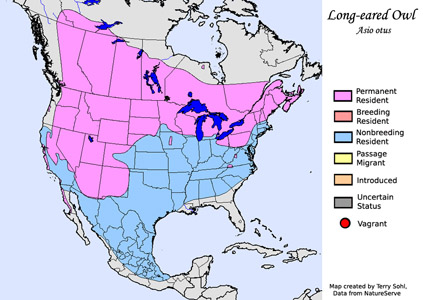 |
| South Dakota Status: Uncommon throughout the state during all seasons, rarer breeder in the eastern part of the state. |
Additional Long-eared Owl Photos
Click for a higher-resolution version of these photos





